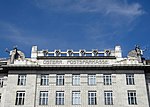Museum of Applied Arts, Vienna

The MAK – Museum of Applied Arts (German: Museum für angewandte Kunst) is an arts and crafts museum located at Stubenring 5 in Vienna's 1st district Innere Stadt. Besides its traditional orientation towards arts and crafts and design, the museum especially focuses on architecture and contemporary art. The museum has been at its current location since 1871. Since 2004 the building is illuminated in the evenings by the permanent outdoor installation "MAKlite" of American artist James Turrell. In 2015 the MAK became the first museum to use bitcoin to acquire art, when it purchased the screensaver "Event listeners" of van den Dorpel. With over 300.000 objects displayed online, the MAK presents the largest online collection within the Austrian Federal Museums. The audio guide to this museum is provided as a web-based app.
Excerpt from the Wikipedia article Museum of Applied Arts, Vienna (License: CC BY-SA 3.0, Authors, Images).Museum of Applied Arts, Vienna
Stubenring, Vienna Innere Stadt
Geographical coordinates (GPS) Address Website External links Nearby Places Show on map
Geographical coordinates (GPS)
| Latitude | Longitude |
|---|---|
| N 48.2075 ° | E 16.381694444444 ° |
Address
Museum für Angewandte Kunst
Stubenring 5
1010 Vienna, Innere Stadt
Austria
Open on Google Maps










